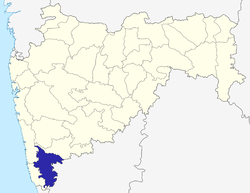Kolhapuri chappal

Kolhapuri chappals are Indian hand-crafted leather slippers that are locally tanned using vegetable dyes. Kolhapuri Chappals or Kolhapuris as they are commonly referred to are a style of open-toed, T-strap sandal which originated from Kolhapur, a southern district in the state of Maharashtra. These are used during festivals as well as day to day purpose.
History
According to historic records, Kolhapuris were first worn as early as the 13th century. Previously known as Kapashi, Paytaan, Kachkadi, Bakkalnali, and Pukari, the name indicated the village where they were made.[1]
Making
It can take up to 6 weeks to make a pair of Kolhapuris.[2] Originally made from buffalo-hide and thread, they weighed as much as 2.01 kilos because of the thickness of the sole, which made them durable despite the extreme heat and mountainous terrain found in the state of Maharashtra.
For making Kolhapuri Chappal various operations are done step by step:-
They are
Skiving
Pattern making and cutting
Attachment of upper and bottom heels.
Stitching
Finishing
Punching and Trimming
Decoration and Polishing
Assembling
Design and durability
The designs have moved from the ethnic to ones with more utilitarian value and materials from primal hard materials to softer and more comfortable to wear materials. The artisans themselves designed ethnic patterns and sold, but today the traders and businessmen with demand for cheap products drive the requirement of minimalist designs.
Kolhapuri chappals are known to last a lifetime if maintained well and not used in rainy seasons.
In the seventies, with the Hippie movement Kolhapuri chappals became a very popular footwear in the United States. The success faded out and recently came back influencing now models that are called toe ring sandals.
Business trend
The business of Kolhapuri Chappals[3] are seen by most as an obsolete trend. The artisan families making Kolhapuri Chappals from generations are moving to new business options as they are unable to meet the needs of the current generations. Kolhapuri Chappals require a continuous supply of quality leather and a change in the legal environment has acted as a catalyst towards the end of this age old art.
References
